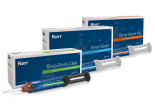|
Premature Set

|
- Abrupt change from heavy to light-body material
- Muted detail around margin
|
- Set time of wash/tray material not synched
- Exceeded working time of material
|
- Begin mix of heavy and light viscosity concurrently
- Verify set times for heavy and light viscosities match
- Observe working time of materials
|
|
Deformation/Dimensional Change

|
- Crowns too tall/short
- Open contacts
- Crown will not seat
|
- Insufficient mix of material
- Impression removed too early
- Tray movement after seating
- Insufficient material elasticity
- Fluid absorption during disinfection process
|
- Verify material is adequately mixed before seating and completely set prior to removal
- Use passive force to maintain tray position when using open-bite technique
- Verify no tooth contact with tray sides or impingement in closed-bite technique
- Choose material with adequate elasticity
- Follow disinfection protocol carefully
|
|
Tearing at Margin

|
- Visible tears at margin
- Lack of flash extending apically around entire preparation
|
- Material has insufficient tear strength
- Presence of severe undercuts
- Insufficient sulcular expansion
|
- Use material with adequate tear strength
- Consider blocking out undercuts, especially in cases with gingival recession
- Ensure at least .5 mm sulcular expansion
|
|
Surface Inhibition or “Non-set”

|
- Unset or mottled surface around preparation
- Lack of detail
- Shiny/wet appearance
|
- Contamination due to latex gloves; direct contact with material or residue left on teeth
- Contamination due to temporary materials or composite
- Expired material or exceeded material shelf life
|
- Use latex-free gloves when handling VPS material
- Rinse preparation area thoroughly after using other restorative materials
- Use automated mixing device to minimize exposure to contaminants
- Do not use expired material
|
|
Poor model detail

|
- Small bubbles/indentations in cast
- Powdery cusps
|
- Release of hydrogen gas from VPS impression after pouring cast
- Tooth contact with mesh lining of closed-bite impression tray
|
- Follow manufacturer instructions regarding any delays for pouring models after taking impression
- Place cotton roll on contra-lateral side when using closed-bite trays to prevent direct tooth contact with tray; this prevents water from leaching through tray after cast has been poured
|
|
Voids in wash material

|
- Visible voids in wash material around tooth preparation
|
- Bubbles incorporated into material during mixing or loading syringe
- Bubbles incorporated while syringing material intraorally
|
- Use automix systems
- Syringe material intraorally in continuous stream around each preparation; do not lift syringe tip from material
|
|
Insufficient or excessive compression

|
- Insufficient: wash material flows away from preparation area
- Excessive: wash material displaced from preparation area; “burn through”
|
• Insufficient compression of wash material from adjacent tooth/tray or heavy-body material
• Excessive compression of wash material due to high viscosity of tray material
|
- Use tray viscosity material with greater compressive force, or use custom tray
- Use tray material with lower viscosity to avoid displacing wash material
|
|
Incomplete margin

|
- Voids or “jumps” on margin
|
- Inadequate tissue management
- Contamination from intraoral fluids
- Insufficient compression of wash material
|
- Use Expasyl™ retraction paste to open sulcus and help maintain dry field
- Use hydrophilic wash material
- Select tray viscosity with adequate compression
|
|
Tooth contact with tray
|
|
- Incorrect size tray
- Tray seating not aligned with dentition
|
- Verify tray has enough room for 2 mm of impression material between tooth and tray walls
|















